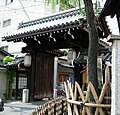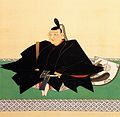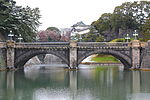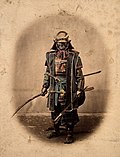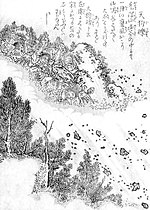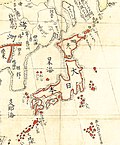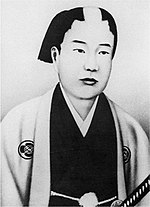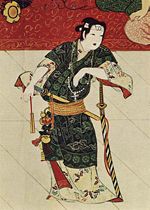police and internal security force. Their new job would be to ensure civil peace, which they accomplished for over 250 years. During the Edo period the...
11 KB (1,267 words) - 08:38, 16 November 2024
in Japan from 1603 to 1868 is known as the Edo period. Before the 10th century, there is no mention of Edo in historical records, but for a few settlements...
21 KB (2,613 words) - 08:19, 31 October 2024
Baton (law enforcement) (redirect from Police baton)
associated problems with electroshock weapons. The jitte was a Japanese Edo period police weapon consisting of a round or octagonal metal rod about 30–61 cm...
43 KB (5,874 words) - 09:23, 28 October 2024
Jitte (category Samurai police weapons)
jitte (十手, "ten hands") is a blunt melee weapon that was used by police in Edo-period Japan (1603–1868). In English-language sources, it is sometimes incorrectly...
8 KB (935 words) - 18:08, 25 September 2024
Tokugawa shogunate (redirect from Edo Shogunate)
baꜜkɯ̥ɸɯ]), also known as the Edo shogunate (江戸幕府, Edo bakufu), was the military government of Japan during the Edo period from 1603 to 1868. The Tokugawa...
53 KB (5,107 words) - 08:18, 31 October 2024
of Toyotomi Hideyoshi, which was moved to Sixth street (六条) when the Edo period started, which was then moved to Shimabara in 1640/41. Shimabara was established...
14 KB (1,952 words) - 17:58, 26 September 2023
disestablishment of the Edo period police system, was part of the Iwakura Mission to Europe, where he gathered information on Western policing; he was mostly inspired...
18 KB (1,319 words) - 18:26, 30 September 2024
Saitō Hajime (category Japanese police officers)
February 18, 1844 – September 28, 1915) was a Japanese samurai of the late Edo period, who most famously served as the captain of the third unit of the Shinsengumi...
22 KB (2,650 words) - 08:16, 27 October 2024
Oniwaban (category Edo period)
refers to the rumor that they were quartered in the garden of Edo Castle. During the Edo period, onmitsu (the term meaning a spy or an undercover detective)...
7 KB (841 words) - 21:45, 29 February 2024
Daimyo (section Edo period)
'private land'. From the shugo of the Muromachi period through the Sengoku period to the daimyo of the Edo period, the rank had a long and varied history. The...
12 KB (1,300 words) - 08:33, 22 November 2024
(夢想 權之助 勝吉, fl. c.1605, dates of birth and death unknown) in the early Edo period (1603–1868) and, according to legend, first put to use in a duel with...
49 KB (6,796 words) - 11:13, 30 August 2024
Yamanami Keisuke (section Shinsengumi Period)
Secretary (Vice Commander) of the Shinsengumi, a special police force in Kyoto during the late Edo period. Though the details of his origin are unclear, he was...
7 KB (811 words) - 02:18, 4 September 2024
Tokyo Imperial Palace (section Edo castle)
indicated whether it would support the project. In the Meiji period, most structures from the Edo Castle disappeared. Some were cleared to make way for other...
27 KB (2,709 words) - 13:53, 6 September 2024
Sasumata (category Samurai police weapons)
sasumata in the Muromachi period, most sources discuss its use in the Edo period. In Edo period Japan the samurai were in charge of police operations. The sasumata...
5 KB (599 words) - 15:57, 25 September 2024
considered the Edo period. Regardless of the dates chosen, the Sengoku period overlaps substantially with the Muromachi period (1336–1573). This period was characterized...
55 KB (5,641 words) - 16:05, 13 November 2024
horse-mounted samurai were no longer the main military force. During the Edo period (1603 to 1868) horses were no longer needed for warfare and the samurai...
11 KB (1,142 words) - 15:19, 17 August 2024
Firearms of Japan (section Edo period)
the average small-scale Edo period conflicts; nevertheless, there were gunsmiths in Japan producing guns through the Edo period. Isolation did not decrease...
16 KB (2,103 words) - 13:00, 28 September 2024
two preceding ones, they were referred to as gokenin. However, in the Edo period, hatamoto were the upper vassals of the Tokugawa house, and the gokenin...
11 KB (1,267 words) - 00:43, 2 November 2024
Samurai (section Heian period)
filled in the past. During the Edo period, they came to represent a hereditary class. On the other hand, from the mid-Edo period, chōnin (townsman) and farmers...
132 KB (16,190 words) - 16:41, 22 November 2024
Law enforcement in Japan (redirect from Police System of Japan)
(2005). "Law Enforcement in the Edo Period". In: Japan Echo, vol. 31 n. 3, June 2005. p. 59-62. National Police Agency Police History Compilation Committee...
33 KB (2,722 words) - 22:52, 15 October 2024
and the two Edo machi bugyō. These last alternated by month as chief administrator of the city. Their role encompassed mayor, chief of police, and judge...
20 KB (2,064 words) - 14:02, 30 June 2024
1797–1831), a Japanese thief and folk hero who lived in Edo (present-day Tokyo) during the Edo period. His exploits have been commemorated in kabuki theatre...
6 KB (580 words) - 14:18, 23 May 2024
attraction for people to see, and as the town dōshin (low-ranking Edo period police) came around to strength the security, the number of stones dwindled...
7 KB (1,081 words) - 13:42, 7 September 2024
History of Japan (redirect from Kamakura–Muromachi period)
shogunate, which governed from Edo (modern Tokyo), presided over a prosperous and peaceful era known as the Edo period (1600–1868). The Tokugawa shogunate...
137 KB (16,278 words) - 12:17, 15 November 2024
the rider's foot eventually replaced the earlier design. During the Nara period, the base of the stirrup which supported the rider's sole was elongated...
4 KB (513 words) - 22:10, 20 March 2024
Okita Sōji (section Shinsengumi period)
of the first unit of the Shinsengumi, a special police force in Kyoto during the late shogunate period. He was one of the best swordsmen of the Shinsengumi...
22 KB (2,994 words) - 08:15, 27 October 2024
Azuchi–Momoyama period (between the end of the Muromachi period in 1573 and the beginning of the Edo period in 1603) as the turbulent Sengoku period drew to a...
5 KB (466 words) - 05:36, 28 August 2024
Kondō Isami (section Shinsengumi period)
1834 – May 17, 1868) was a Japanese swordsman and samurai of the late Edo period. He was the fourth generation master of Tennen Rishin-ryū and was famed...
20 KB (2,180 words) - 08:15, 27 October 2024
Meiji era (redirect from Meiji Period)
prince, marquis, count, viscount, and baron. In the transition between the Edo period and the Meiji era, the Ee ja nai ka movement, a spontaneous outbreak of...
66 KB (8,053 words) - 12:57, 21 November 2024
Fires in Edo (江戸), the former name of Tokyo, during the Edo period (1600−1868) of Japan were so frequent that the city of Edo was characterized as the...
56 KB (7,237 words) - 16:36, 23 August 2024






